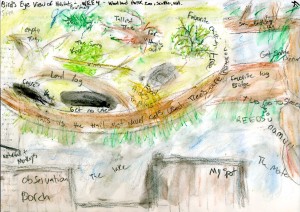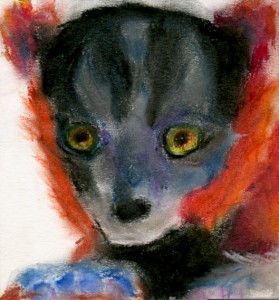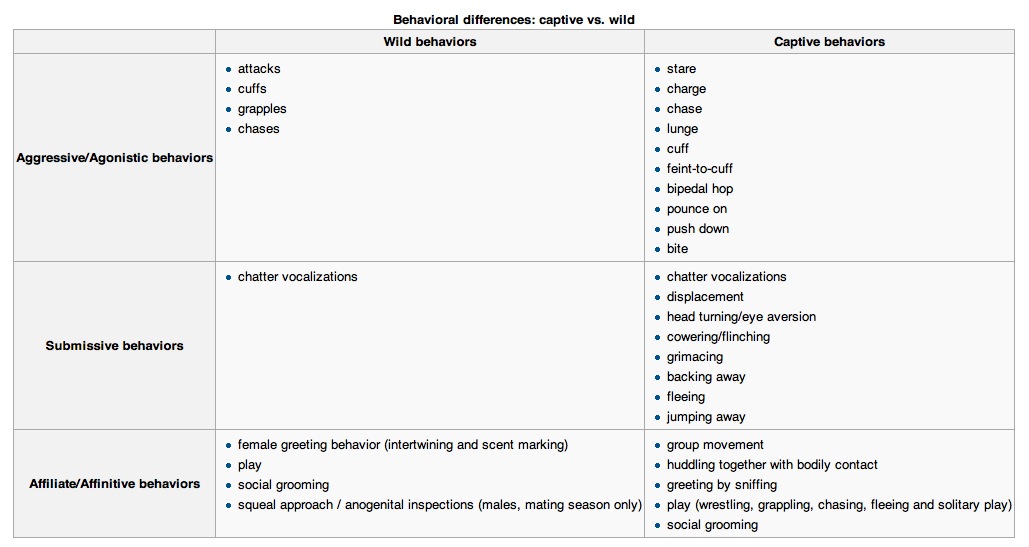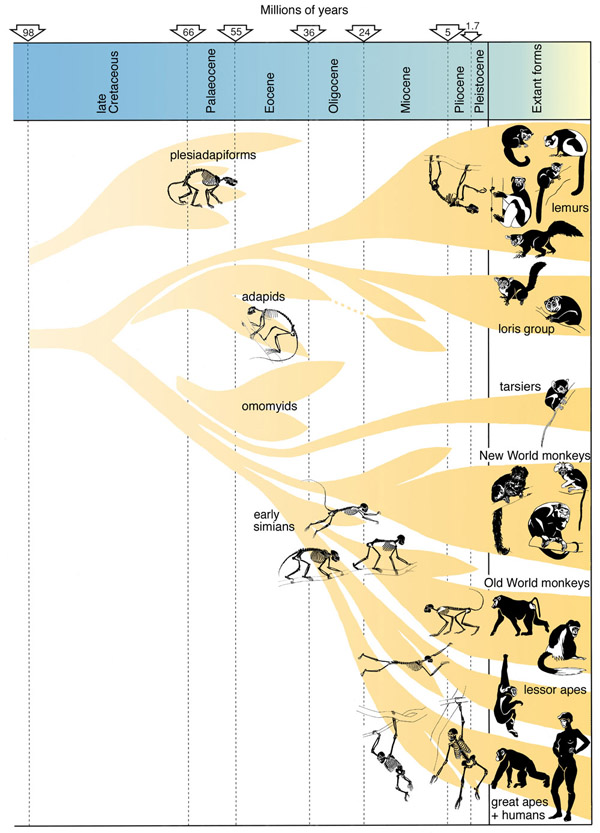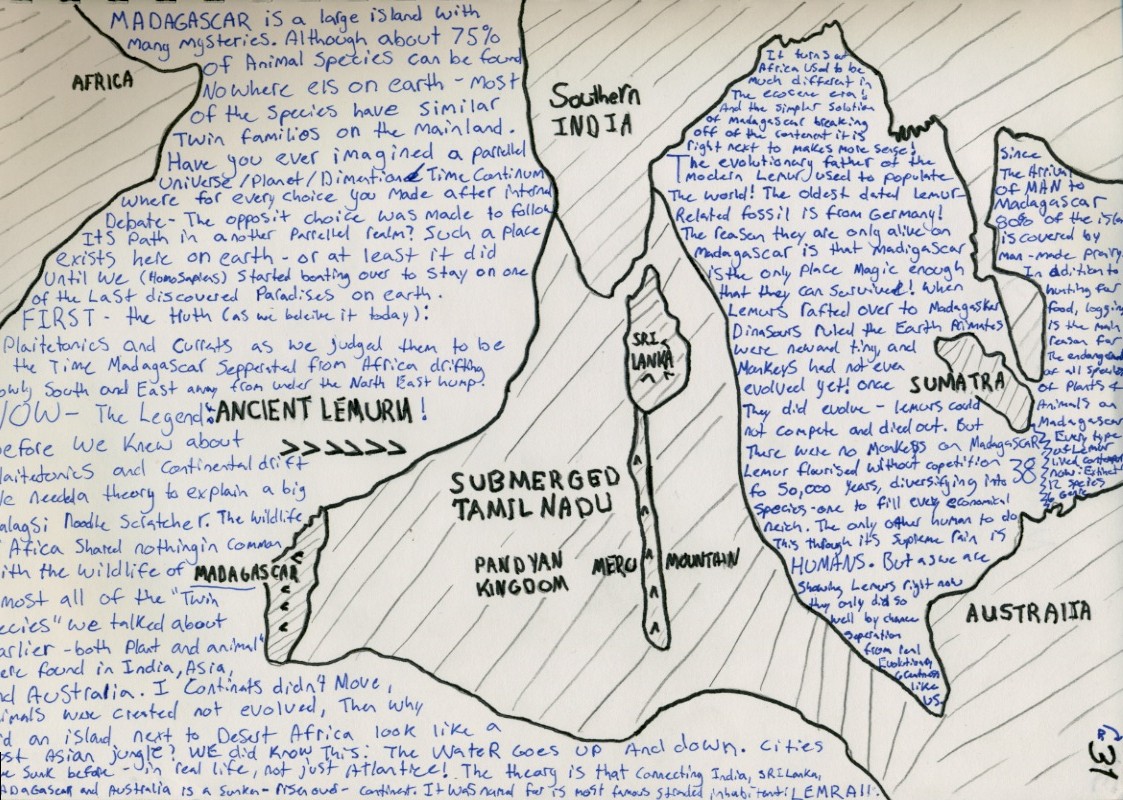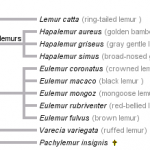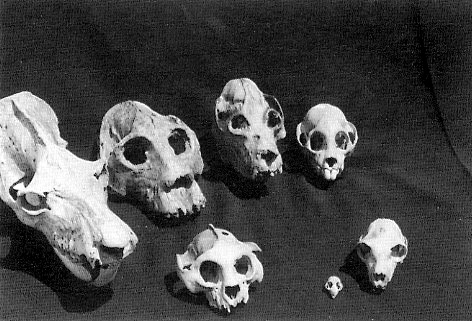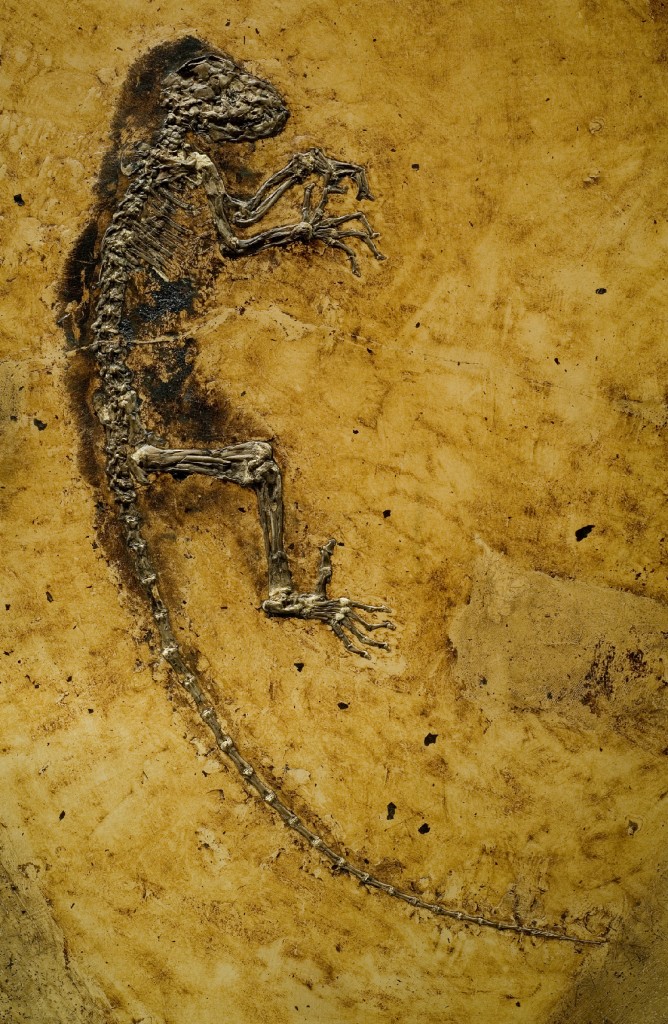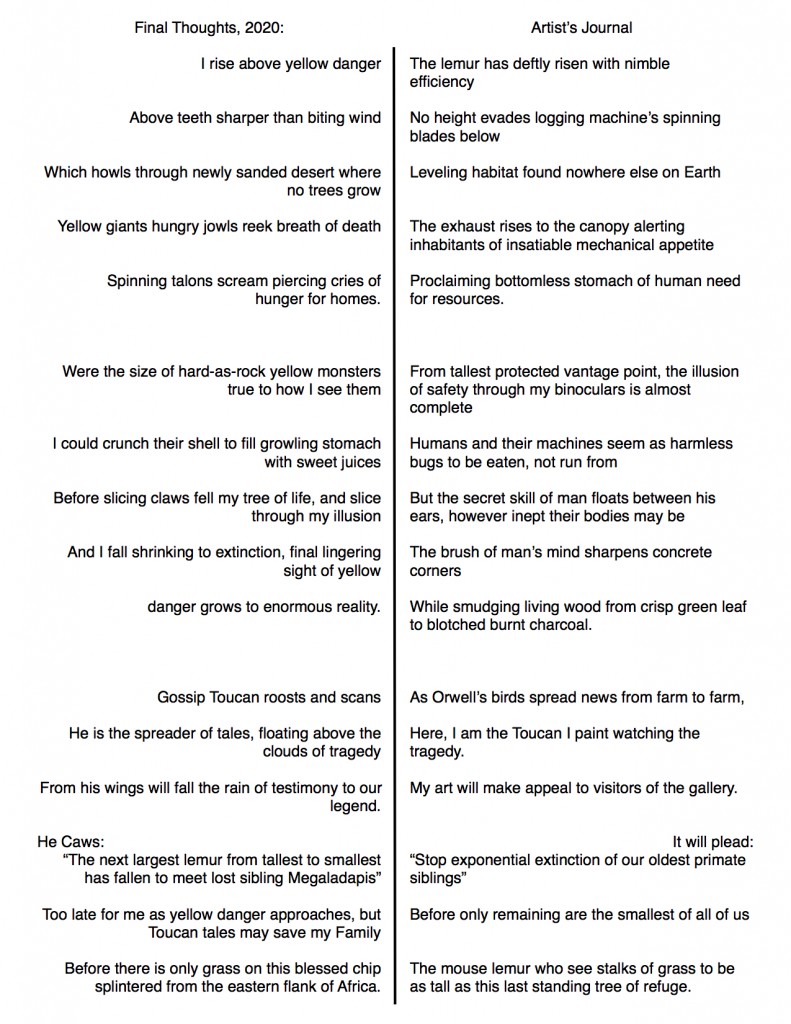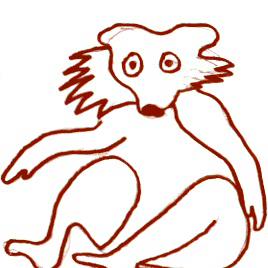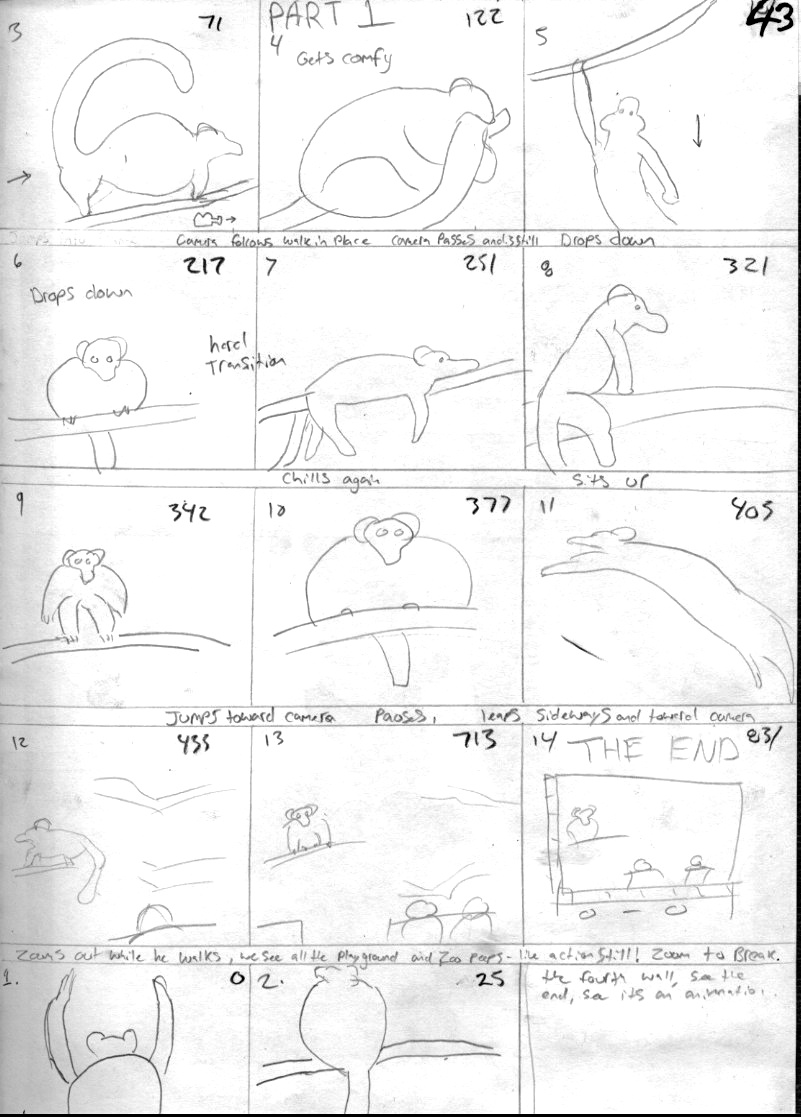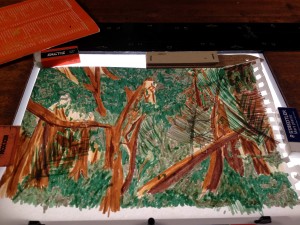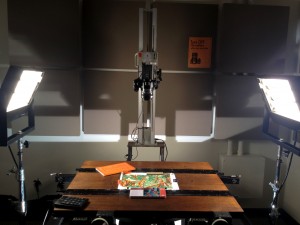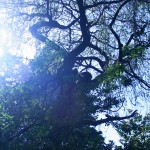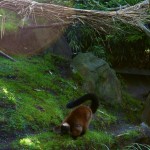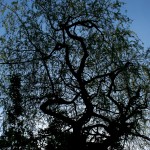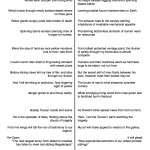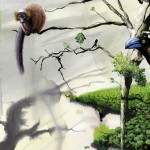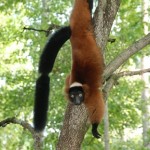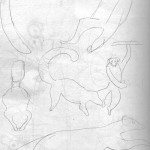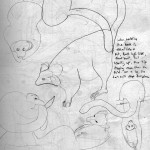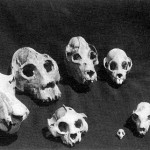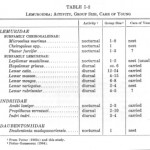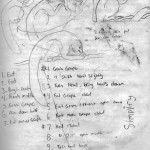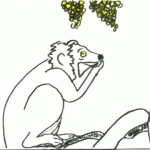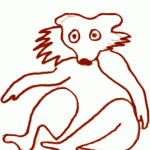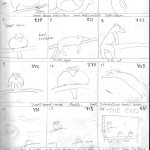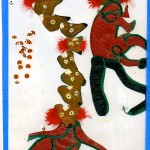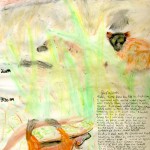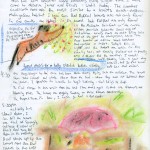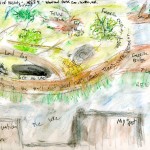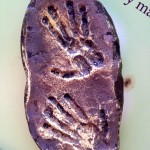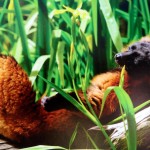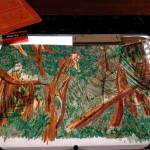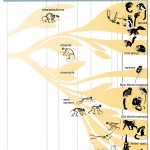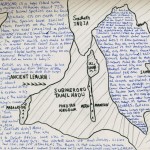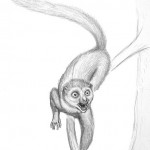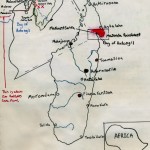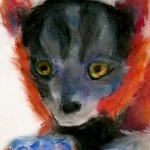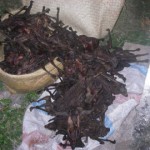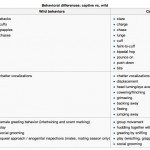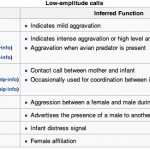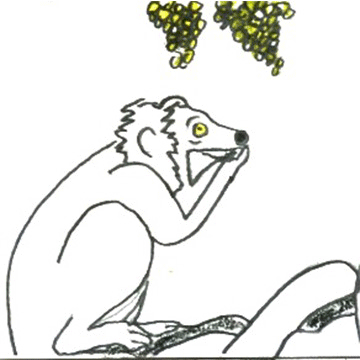
Animalia - Chordata - Mammalia - Primates - Lemuridae - Varecia - V. Rubra
Over the course of 10 weeks I have observed Jamer, a male Red Ruffed Lemur in a troop of three living in the Woodland Park Zoo Lemur Habitat. Interlaced with my observation I have conducted visual and informational research on Red Ruffed Lemurs, and I have explored human animal relationships through creative writing, and illustration. I considered my animal and other animals in terms of their pure selves, as well as the way they represent humans, effect humans, the way humans effect them, and finally the merging and dividing of the space between animal and human. My work regarding Jamer is compiled into a 9×11″ sketchbook on display in June 2012 at The Evergreen State College. Included on this page are research elements, excerpts from my animal book, as well as additional digital content such as clips from related media, and several animations exploring the natural and character aspects of Red Ruffed Lemurs.
ARTIST STATEMENT
I, Korbin Bennett-Gold, am motivated to spread the good practices of sustainability and justice among all people. The country of Madagascar is tragically effected by these principals going to the wayside. The lemurs are icons of the injustice displayed during the clash between expansionist humans and an environment evolved without flourishing predators (as in Eden).
I explored the Red Ruffed Lemur through creative writing, observation, and research. My early animations stimulated detailed questions which in turn enhanced the depth of my observational sessions, and the breadth of my learning. My Research influenced engagement in my weekly observations. Discovering shared ancestry with Darwinius masillae – the linking animal between prosimians and simians before they diverged – connects me to the lemurs as a child looks for his own face in the wrinkly creases of his grandparent’s. My anti-human rhetoric thankfully softened in my writing due to continued research and broader understanding of the powers in play. I transitioned from attacking human destructionism to representing a conversation between the sympathetic and lobbying approaches to environmental activism.
Through studying animals my vision has switched from seeing separate nations of people to recognizing our species as one. Humans together tipping a branch of diverse historical animal ancestors growing from the oceanic roots of the tree of life.
Life facts of a Red Ruffed Lemur
Out of all the amazing placees to live, Red Ruffed Lemurs have picked one small corner of Madagascar to call their own do death do they part. Which it may come to. But luckily due to their endangered level, and their habitat in common with even more endangered species of lemur than themselves, much of the Red Ruff spot is protected inside Masoala Nation Park in the Masoala Rain Forest on the -you guessed it – Masoala Peninsula in the north eastern and wettest part of Madagascar.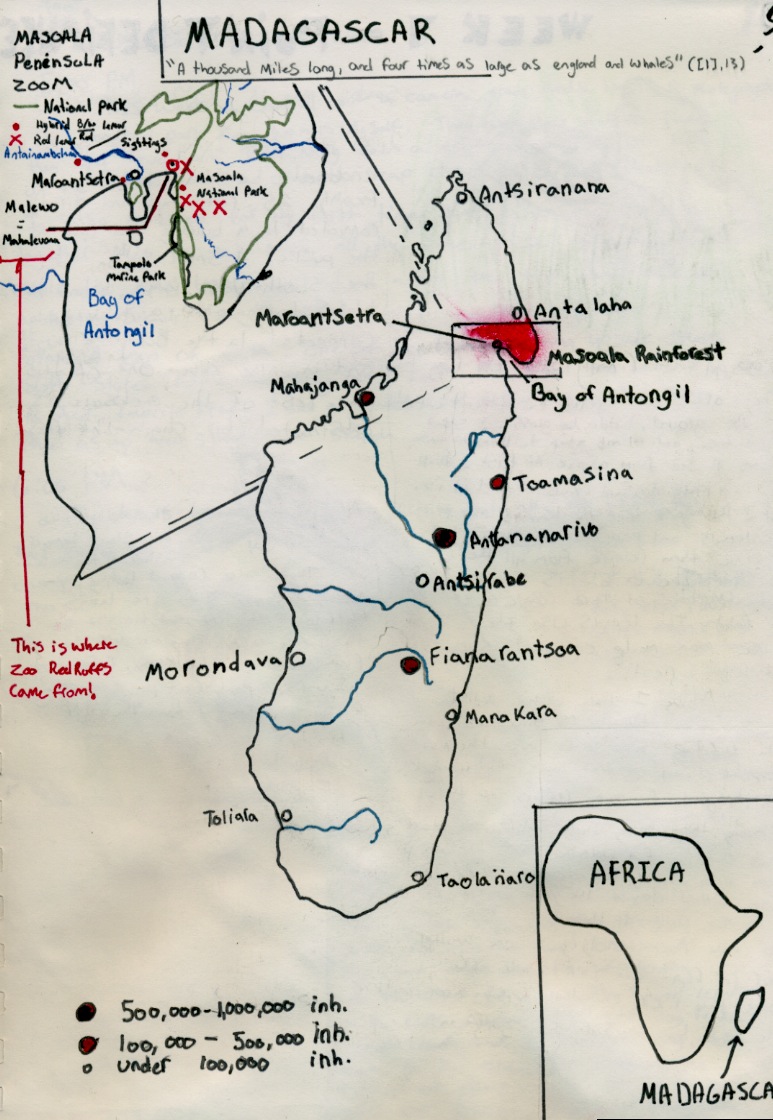
Lemurs only reproduce in time for the rainy season once a year when the food is good. Ruffed Lemur are a little bit special when it comes to their offspring, because they almost always have twins. The mother does not carry the young on her back as some lemurs do, or in a pouch as others still, but leaves them alone 35-60 feet above the ground in a tree nest. Fruit, nectar, and pollen are typical food, figs and mangos are preferred. Leaves and seeds for dinner if fruit becomes scarce.
An average Red Ruffed Lemur will live 20 years in the wild! The tail is longer than the body at 23.5 in verses 20 inches tall. Weight is only 8lbs, females are larger. Priority goes to Wemon and Children when it comes to Lemurs. Behavior indicates matriacle society, however the males have a clear hierarchy which sometimes needs to be worked out.
Lemurs use calls and scent to communicate between each other. Lemurs will understand calls from the same family different species, but will not usually respond. From lemurs of a different family Languages are different. Red Ruffed Lemurs are one of the only groups to use group calls which may be heard from miles around.
Click to enlarge Call type details:
NATURAL HISTORY
Origen
The Above Reads:
“Madagascar is a large island with many mysteries. Although about 75%(xiii, [9]) of animal species can be found nowhere else on earth-most of the species have similar twin families on the mainland. Have you ever imagine a parallel universe/planet/dimension/time continuum where for every choice you made after internal debate-the opposite choice was made to follow its path in another parallel realm? Such a place exists here on Earth-or at least it did until we (Homo sapiens) started boating over to stay on one of the last discovered paradises.
FIRST-the truth (as we believe it today):
Plate tectonics and currents as we judge them to be at the time Madagascar separated from Africa drifted the island slowly south and east away from the North East hump.
NOW-the legend: Ancient Lemura!
Before we knew about plate tectonics and continental drift we needed theory to explain a big Malagasy noodle scratcher. The wildlife of Africa shares nothing in common with the wildlife of Madagascar. Almost all of the “twin species” we talked about earlier-both plant and animal-were found in India Asia and Australia. If continents didn’t move, animals were created not evolved, then why is an island next to desert Africa look like a lost Asian jungle? We did know this: the water goes up and down. Cities have sunk before-in real life, not just Atlantis! The theory is that connecting India, Sri Lanka, Madagascar, and Australia is a sunken/risen over continent. It was named for the most famous stranded inhabitant: Lemura!!!
It turns out Africa used to be much different in the Eocene era And the simpler solution of Madagascar are breaking off of the continent it is right next to makes more sense! The evolutionary father of the modern lemur used to populate the world! The oldest dated fossil is from Erope! The reason they are only alive on Madagascar is that Madagascar is the only place magic enough that lemurs can survive! When lemurs rafted over to Madagascar while dinosaurs ruled the earth, primates were new and tiny, monkeys had not even evolved yet! Once they did evolve-lemurs could not compete! But there were no monkeys on Madagascar lemurs flourished without competition for 50,000(2, [3]) years, diversifying into species-one to fill every ecological niche. The only other animals do this during the same free reign, are humans. But as we are showing the lemurs right now, they only did so well by chance separation from real evolutionary greatness like us.
Since the arrival of man in Madagascar 80% of the island is covered by man-made Prairie(xiii, [9]). In addition to hunting for food logging is the main reason for the endangerment of all species of plants and animals on Madagascar. All types of lemur lived contemporarily together. Now: extinct 12 species 6 genre.”
Taxonomy and Ancient History
Genus: Varecia Variegate Rubra. Translated this means various colored, red. Red Ruffed Lemurs are one of only two types of lemurs in the Variegate Genus, a subclass of the Genus Lemur, which is only a part of the greater category of animals we consider to be “Lemurs” (See Table Right). Variegate was part of the original group to establish itself on Madagascar and is not a delineated branch of the Lemur tree. “The Genus Lemur was named by Linnaeus for the lemures, luminous-eyed ghosts of the roman dead.”(Treherne, 187).There are 13 living and 6 extinct genera – 26 living species and 12 extinct (184). Only within the last 1,000 years(184) have lemur species declined in
population. This time frame reflects the beginning of human migration to Madagascar. All of the currently existing lemurs co-existed with their larger siblings for over 50,000(2, [3]) years before hunting destroyed any lemur large enough to be easily hunted. There are records of biped-lemurs, flat-faced lemurs, and lemurs weighing over 250 lbs rivaling apes in size(200). Today, the mouse lemur holds the position of the worlds smallest primate. Like all primates on Madagascar, Lemurs are prosimians, meaning they came before apes. In fact, lemurs were located throughout the world in the pre-historic age before Madagascar flaked off of africa. The oldest lemur skeleton is in Europe. Monkeys evolved from the same early primate as lemurs 20 million years after Madagascar split. This half monkey ancestor/half lemur ancestor was discovered in Germany recently placing the final link in the chain which connects lemurs, humans, and monkeys as direct decedents of a very lemur like creature named Ida (ee-da ) the only known member of her species Darwinius Masillae.
The monkeys were smarter than lemurs due to a brain development towards object recognition over primary scent use. Lemurs could not cohabitate with monkeys and died off. However Monkeys were too late in time to cross to Madagascar as the plates shifted, isolating Lemurs and other species to that island with no prevailing predators to champion over the gentler species. For this reason 90% of forest species, five scientific families of mammals, six of plants, and four of birds exist only in Madagascar(xiii, [9]).
Cultural History
The culture which goes furthest back with the lemurs are the native people of Madagascar – the Malagasy. The Malagasy are not native in my strictest sense of the word, but the culture comparison on the island today is very similar to a euro-conquered native culture in any of the many other examples of that around the world. Malagasy people are Polynesian in oregon, but did live mostly undisturbed on Madagascar for hundreds of years. The Malagasy’s greatest harm to lemurs drastically disturbed some, while remaining harmonious with others. Perhaps in an equal world loosing some of the lemur species to find a balace with the remainder would be ideal. Lemur extinction flows in in one direction – biggest to smalles. Large, slower, and lower to the ground – the great lemurs of ancient history were easy targets for the first men on the jungle. The Red Roughed Lemur is now the largest remaining lemur species, and if the pattern is any indication – the next to go on the list. These days Lemur makes a good beef on a stick.
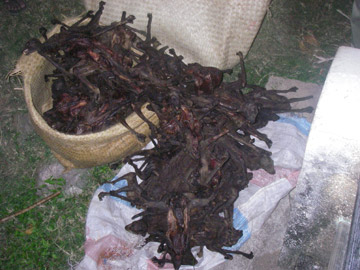
Deep Fried Lemur. Butler, Rhett A. "Appalling Photos Reveal Lemur Carnage in Madagascar." Wildmadagascar.org. 20 Aug. 2009. Web. 30 Apr. 2012.
It is often deep-fried at bars as a crispy snack. The most delicious, the locals will tell you, are the Red Ruffed Lemurs. Below is a clip from a BBC exposé on illegal log trade in Madagascar. While the med go out for ebony for the boss, catching Red Ruffed on the side is great fun – with no concern for protected national park or not.
http://youtu.be/-zjiLSU177U
Speaking of logging trade, that brings us to todays top predator for Red Ruffed Lemurs: the value of the wood it lives in. The western worlds reach into the lemur’s habitat with a much heavier hand than the spear wielding Polynesian castaways. With airports, exports, and a piece of heaven to sell, forests are getting decimated at an alarming rate, and the population is exploding in response to the money to be made while the nature lasts. In the above documentary they sighted over 50 logs being floated down the river per day from the protected forest. Each log is worth 4,000$ on the black market, the logs followed in this story reach back to gibson guitar necks via a middle company in Germany.
Lemurs have other connections to the Malagasy besides as food. Malagasy people are traditionally delf regulated by taboos called fady. There are fady about certain lemurs which may be good or bad for the lemur itself. The Aye-Aye -a nocturnal lemur- are considered bad luck. They are killed on sight in a village. Most lemurs, however, are protected under a taboo against killing them. “There are several stories about the taboo’s origins. One says that a man who fell out of a tree while collecting honey was protected by a lemur; according to another, lemurs are human’s ancestors.”([2])
Most people who do know of lemurs in America know of them from this man voiced by Sacha Baron Cohen
The personality train that identifies all the lemurs in the Madagascar film series is Party TIme. The most iconic element of the first film was the song “I like to Move It” sung by the lemurs. They played this song during workouts at a cross country camp I went to in high school. I feel like this is a natural character decision as lemurs spend most of their day looking around for food and jumping from tree to tree – in groups of up to 30 for the ringtails like King Julian. It is a party all the time. The angle of a depressed lemur with no home is well played on the sympathies of supporters for the cause, but it is opposite from the feelings of those lemurs who remain – and do because they have not yet been found by man. Those lemurs, I think are partying harder than julian and his whole troop.
My first personal lemur exposure was through the EnviroKids Cereal Leapin Lemurs!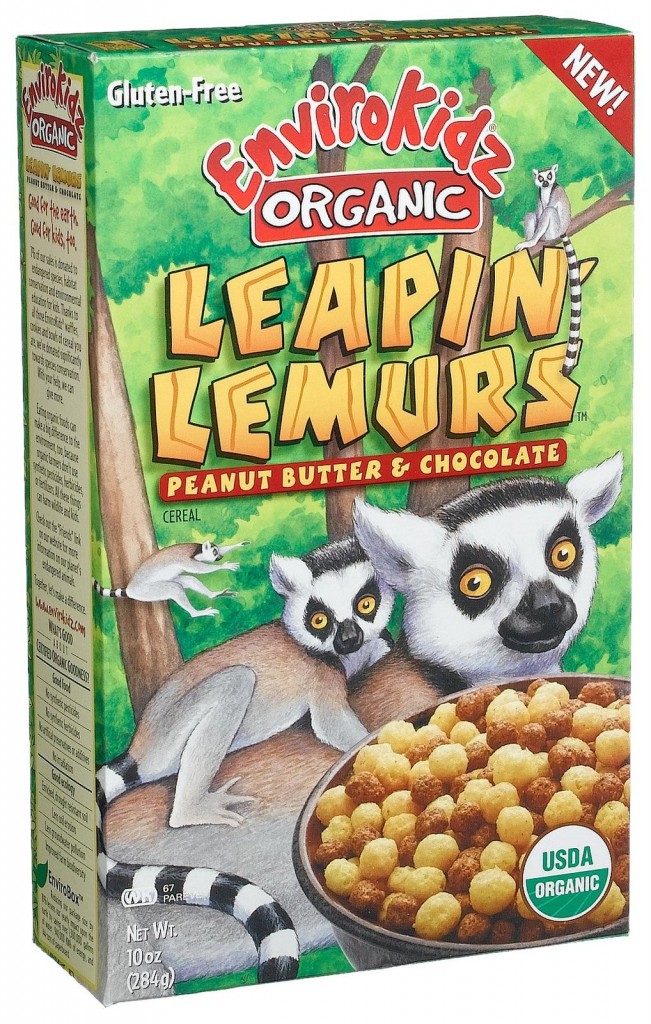
This cereal is umm umm good, I eat it all the time and feel cool.
Observation selections

- This is the only week where I entered my own illustration as a character. The rain that day created too silly a situation to leave myself out. These drawing were done with chalk pastels.

- These paintings were done with watercolor crayon, finger smudging, and water color pensil. On the bottom image I used the pensil to create a solid rubbing pallet from which to paint with a brush.
Ekphrastic Writing
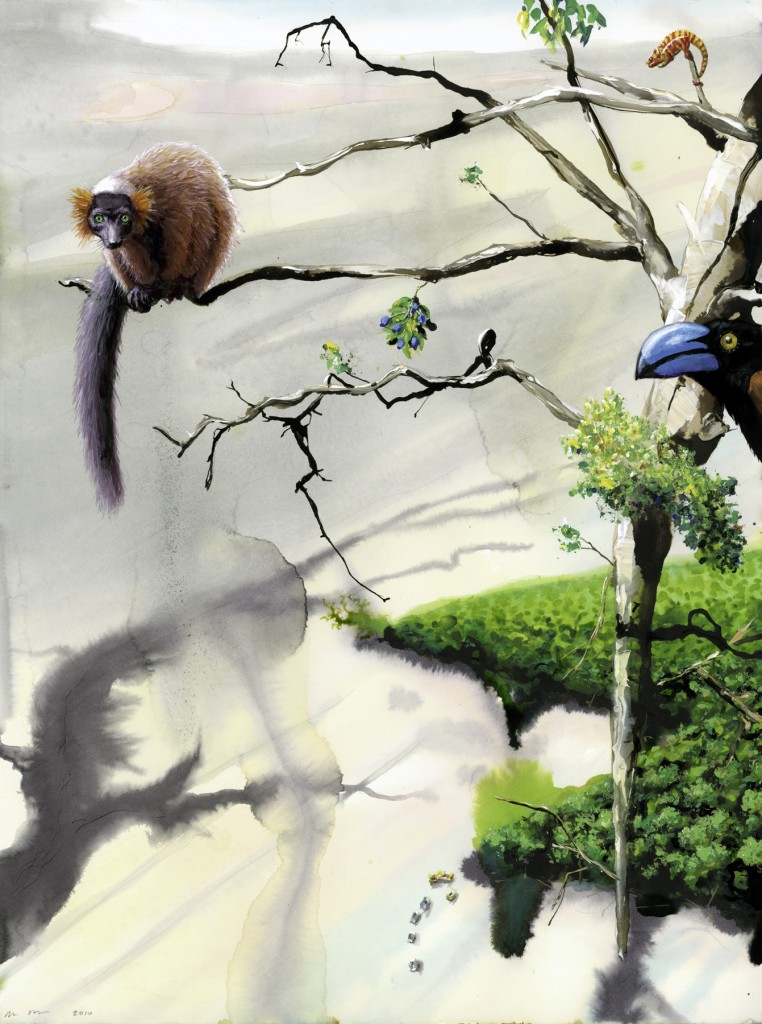
- Rockman, Alexis. Fragments. Dec. 2009. Smithsonian American Art Museum, Washington D.C. Lemur Conservation Foundation. Web. April 23 2012.
Animations
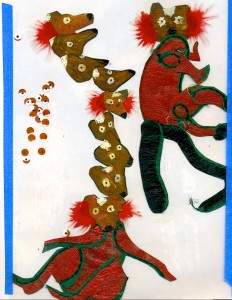
- Cutout articulated lemur puppet including transitional heads and eyes for transitioning from one position to next and blinking, respectively..
http://youtu.be/qC6R8_HyXJ4?t=4s
- Red Ruffed Lemurs Sitting In Trees, Woodland Park Zoo, Seattle. Personal photograph by author. 2012.
- Lemur Silhouette, Woodland Park Zoo, Seattle. Personal photograph by author. 2012.
- Lemur Sniffing Ground, Woodland Park Zoo, Seattle. Personal photograph by author. 2012.
- Tree Silhouette, Woodland Park Zoo, Seattle. Personal photograph by author. 2012.
- Rockman, Alexis. Fragments. Dec. 2009. Smithsonian American Art Museum, Washington D.C. Lemur Conservation Foundation. Web. April 23 2012.
- A Red Ruffed Lemur Relaxes at the Center. 2007. Photograph. Duke University, Durham, NC. Duke Today. Duke University, 4 May 2007. Web. 4 June 2012.
- Upside down Red Ruffed Lemur. Photograph. Duke Photography, Durham, NC. Duke Lemur Center. Duke University. Web. 4 June 2012.
- Parsons, Dave. Red Ruffed Lemur Quadruplets Born at Denver Zoo! 2011. Photograph. Denver Zoo, Denver. ZooBorns. 7 Apr. 2011. Web. 4 June 2012.
- Skulls of Extinct Lemurs
- 12 frame Animated Zoetrope strip of a Raccoon drawn by Ariety Fried, animated by me into a Lemur
- Only the first three frames were shot – major time underestimation!
- Cutout articulated lemur puppet including transitional heads and eyes for transitioning from one position to next and blinking, respectively..
- Red Ruffed Lemur Handprint
- Animation 3 axis table
- Lemur Taxonomy. Click to Enlarge
- Primate Evolutionary Tree. Click to Enlarge
- An imagined illustration depicting the extinct Sloth Lemur. Click to Enlarge.
- King Julian from the movie “Madagascar”
- Click to Enlarge
- Ida’s Fossil. Darwinius Masillae.
- Deep Fried Lemur. Butler, Rhett A. “Appalling Photos Reveal Lemur Carnage in Madagascar.” Wildmadagascar.org. 20 Aug. 2009. Web. 30 Apr. 2012.
Lemurs are just gentle humans who did things the nice way. It worked out for a while.
Bibliography
Works Cited
[1] Attenborough, David. Bridge to the past Animals and People of Madagascar. New York: Harper & Brothers, 1961. Print.
[2] Butler, Rhett A. “Appalling Photos Reveal Lemur Carnage in Madagascar.”Wildmadagascar.org. 20 Aug. 2009. Web. 30 Apr. 2012.
[3] Jolly, Alison. Lemur Behavior; a Madagascar Field Study. Chicago: University of Chicago, 1966. Print.
[4] Jones, Julia P., Mijasoa A. Andriamarovolona, and Neal J. Hockley. “Taboos, Social Norms and Conservation in the Eastern Rainforests of Madagascar.” BIOdiversity and Economics for Conservation (2007). BIOECON. Web. 30 Apr. 2012.
[5] Lemur Silhouette, Woodland Park Zoo, Seattle. Personal photograph by author. 2012.
[6] Lemurs Sitting in Trees, Woodland Park Zoo, Seattle. Personal photograph by author. 2012.
[7] McKenna, Katharine L. Red Lemurs. Woodstock NY. Lemur Conservation Foundation. Web. 30 Apr. 2012.
[8] Parsons, Dave. Red Ruffed Lemur Quadruplets Born at Denver Zoo! 2011. Photograph. Denver Zoo, Denver. ZooBorns. 7 Apr. 2011. Web. 4 June 2012.
[9] Paulian, Renaud, Jean-Louis Guillaumet, and R. Rabesandratana. Key Environments: Madagascar. Oxford: Pergamon, 1984. Print.
[10] Reardon, Sara. “Falling Taboos Put Lemurs on the Menu in Madagascar.” Science. 15 Dec. 2011. Web. 6 June 2012.
[11] A Red Ruffed Lemur Relaxes at the Center. 2007. Photograph. Duke University, Durham, NC. Duke Today. Duke University, 4 May 2007. Web. 4 June 2012.
[12] Rhabwar-Troll-Stock. Ancient Lemur Smilodectes. Photograph. Smithsonian Art Museum of Natural History, Washington, DC. Deviant Art. Web. 30 Apr. 2012.
[13] Ross, Deborah. LCF Art Colection. Lemur Conservation Foundation. Web. 30 Apr. 2012.
[14] Tattersall, Ian. The Primates of Madagascar. New York: Columbia UP, 1982. Print.
[15] Upside down Red Ruffed Lemur. Photograph. Duke Photography, Durham, NC. Duke Lemur Center. Duke University. Web. 4 June 2012.


